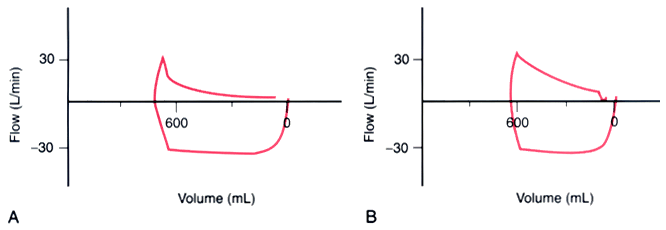 |
 |
Figure 36-24
Flow (ordinate) versus volume (abscissa). A,
Closed-chest positive-pressure ventilation under general anesthesia in a patient
with severe airways obstruction and hyperinflation before surgery to reduce lung
volume. The flow-volume curve shows inspiratory (negative) and expiratory (positive)
flow on the ordinate, plotted clockwise from zero volume on the abscissa. Expiratory
flow started with a sharp upward peak and then fell immediately to a low flow rate
with convexity toward the volume axis, suggesting expiratory flow limitation. expiratory
flow rate was so low that inflation of the next positive-pressure breath was initiated
before expiratory flow reached zero. Because expiratory flow continued up to this
point, there must have been intrinsic positive end-expiratory pressure (PEEPi).
B, A similar closed-check flow-volume curve after
lung resection shows that the characteristic pattern of expiratory flow limitation
has disappeared and that expiratory flow rate fell to zero before inflation started
for the next breath (i.e., no suggestion of PEEPi). (Adapted from Dueck
R: Assessment and monitoring of flow limitation and other parameters from flow/volume
loops. J Clin Monit Comput 16:425, 2000.)

 |
